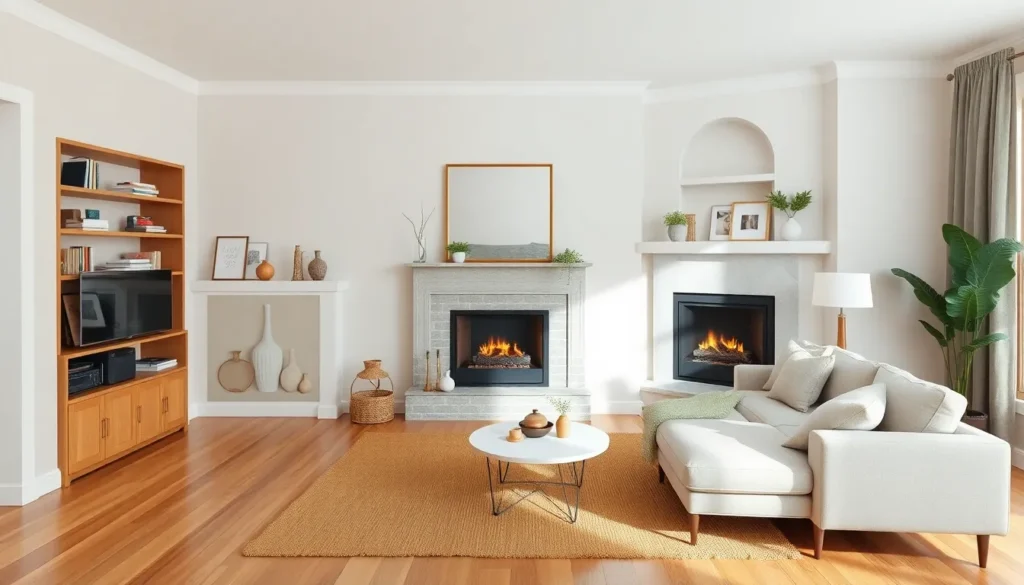Small living rooms with fireplaces present a unique design challenge that we’ve all faced at some point. How do you create a cozy yet functional space when you’re working with limited square footage and a prominent architectural feature that demands attention?
We understand the struggle of balancing style with practicality in compact spaces. A fireplace can be both a blessing and a design dilemma – it’s an instant focal point that adds warmth and character but can also dominate a small room if not handled thoughtfully.
The good news? We’ve discovered countless creative answers that’ll transform your petite living room into a stunning sanctuary. From strategic furniture placement to clever storage hacks and color tricks that make spaces feel larger, these ideas will help you maximize every inch while keeping your fireplace as the star of the show.
Maximize Vertical Space With Floor-to-Ceiling Built-Ins
Floor to ceiling built ins transform vertical walls into functional storage powerhouses while maintaining your small living room’s open feel. Smart vertical answers help you avoid cluttering limited floor space around your fireplace.
Custom Shelving Around the Fireplace
Built in shelving flanking your fireplace creates symmetrical storage that draws the eye upward and makes ceilings appear taller. We recommend installing floating shelves or recessed bookcases on both sides of the fireplace to maintain visual balance.
Consider these custom shelving options for maximum impact:
Asymmetrical arrangements work beautifully when you have different wall lengths on each side of your fireplace. Install wider shelving on the longer wall and narrower floating shelves on the shorter side to create visual harmony.
Mixed depth shelving provides versatility for displaying both books and decorative objects. Deep shelves accommodate storage baskets and larger items while shallow shelves showcase artwork and small collectibles.
Integrated lighting within custom shelving illuminates your displays and adds ambient lighting to your small living room. LED strip lights or small puck lights create a warm glow that complements your fireplace’s natural light.
Color coordination between your shelving and walls makes the space feel larger and more cohesive. Paint built ins the same color as your walls to create a seamless look that doesn’t compete with your fireplace focal point.
Wall-Mounted Storage Answers
Wall mounted cabinets and shelving systems free up valuable floor space while providing essential storage in your compact living room. Strategic placement of these answers creates functional zones without blocking natural light flow.
Floating media consoles mounted below or beside your fireplace house electronics and media components without taking up floor space. Choose sleek designs that complement your fireplace surround materials.
Modular wall systems offer flexibility to rearrange storage components as your needs change. These systems typically include various shelf sizes cabinet options and hanging elements that adapt to your small living room layout.
Corner wall shelving maximizes often overlooked vertical space in room corners. Install triangular floating shelves or corner mounted cabinets to store items you use frequently but want to keep within easy reach.
Above door storage utilizes the space between door frames and ceilings for seasonal items or books. Install narrow shelving or small cabinets in these areas to squeeze extra storage from every available inch.
Choose Multi-Functional Furniture Pieces

Smart furniture selections can transform your small living room with fireplace into a highly functional space. We’ll explore pieces that serve multiple purposes while maintaining style and comfort.
Ottoman Storage Benches
Ottoman storage benches provide additional seating and storage in one compact piece. We love how these versatile pieces can double as coffee tables when topped with a decorative tray near your fireplace area.
Place these benches strategically around your room to create flexible seating arrangements for guests. Storage compartments inside can hold blankets, pillows, games, or seasonal items that would otherwise clutter your limited space.
Choose ottomans with sturdy tops that can support weight and withstand daily use. Fabric options like linen or leather complement fireplace settings while offering durability for high traffic areas.
Nesting Tables and Expandable Options
Nesting tables create flexibility in seating and dining arrangements without permanently occupying floor space. We recommend sets that tuck completely under each other when not needed, leaving more room for foot traffic around your fireplace.
Pull out individual tables when entertaining guests or enjoying meals by the fire. These pieces work exceptionally well in corners or beside seating areas where traditional coffee tables might feel too bulky.
Expandable dining tables offer similar space saving benefits for small living rooms that serve multiple functions. Look for drop leaf designs or tables with removable sections that can accommodate different group sizes.
Sofa Beds and Convertible Seating
Sofa beds offer extra sleeping space or seating options without requiring a separate guest room. We suggest sleeper sofas with easy conversion mechanisms that won’t strain your back during setup.
Consider sectional sofas with built in storage compartments or pull out beds for maximum functionality. These pieces work particularly well when positioned to face your fireplace, creating a cozy entertainment zone.
Convertible seating like daybeds or futons can serve as both comfortable daily seating and overnight accommodations. Choose styles with clean lines that complement your fireplace’s aesthetic while providing practical sleeping answers for unexpected guests.
Create a Focal Point With Strategic Fireplace Styling
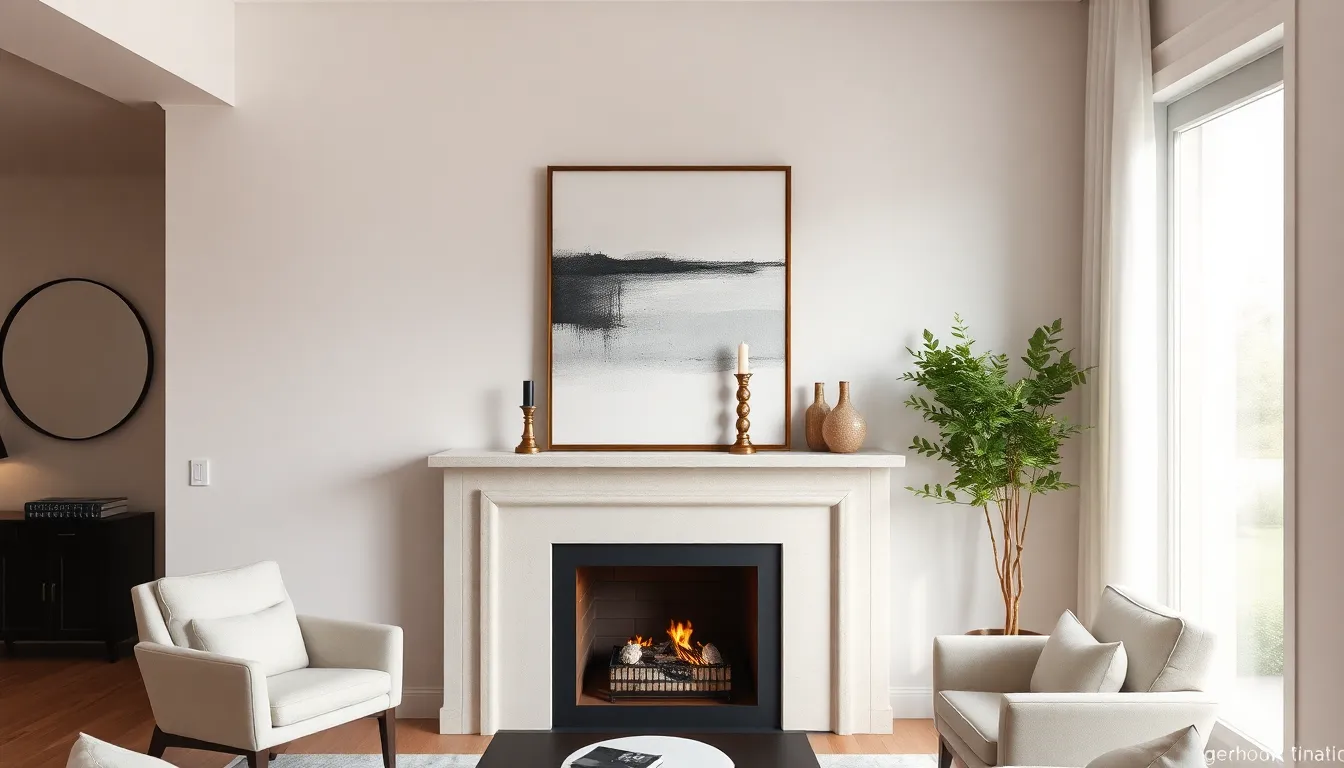
Transforming your fireplace into a commanding centerpiece requires thoughtful design choices that complement rather than compete with your small living room’s dimensions. Strategic styling ensures your fireplace becomes the room’s natural focal point while maintaining visual balance.
Mantel Decorating Ideas for Small Spaces
Minimalist approaches work best when decorating mantels in compact living rooms. We recommend selecting just a few statement pieces rather than crowding the surface with multiple decorative items. A single large piece of artwork, paired with two matching candlesticks, creates more visual impact than many small objects scattered across the mantel.
Balance becomes crucial when your mantel decorating doesn’t overwhelm the surrounding space. Keep decorative elements proportional to your fireplace size, typically choosing pieces that are one-third the width of your mantel for optimal visual weight. Clean lines and uncluttered arrangements prevent the mantel from visually weighing down your room.
Seasonal rotations allow you to refresh your mantel’s appearance without permanent commitment to exact decorative schemes. Store alternative decorative pieces in nearby built-in storage or floating shelves, making it easy to swap out items while maintaining the minimalist aesthetic that works best in small spaces.
Mirror Placement to Enhance Room Size
Reflective strategies using mirrors can dramatically increase the perceived size of your small living room when positioned thoughtfully around your fireplace. Place a large mirror directly above the mantel to reflect light from windows and other sources throughout the room, creating an illusion of expanded space that makes your living area feel more open and airy.
Optimize visibility by positioning mirrors to capture and reflect natural light sources, such as windows or glass doors. This technique enhances brightness while doubling the visual impact of your room’s existing light, making the space feel larger and more welcoming. Consider angling mirrors slightly to reflect the most attractive views of your room rather than positioning them perfectly straight.
Strategic placement beside the fireplace can also work effectively, especially when you mount mirrors on adjacent walls to create a wraparound reflective effect. This approach works particularly well with corner electric fireplaces, where mirrors on both connecting walls can make the corner area feel more spacious and integrated with the rest of your living room.
Optimize Furniture Arrangement and Traffic Flow

Strategic furniture placement transforms small living rooms with fireplaces into functional and inviting spaces. We’ll explore proven arrangements that maximize both comfort and movement.
Angled Seating Configurations
Angled seating creates intimate conversation areas while maximizing your room’s potential. We recommend positioning your sofa or chairs at 45-degree angles to the fireplace, which naturally draws people toward the warmth while opening up walking paths. This arrangement works particularly well with L-shaped sectionals or two accent chairs flanking a small side table.
Consider placing your main seating piece diagonally across from the fireplace rather than parallel to it. This positioning allows for better sightlines throughout the room and creates multiple conversation zones. Angled furniture also softens the rigid lines that often make small spaces feel cramped and boxy.
We’ve found that angled arrangements work best when you anchor them with area rugs that define each seating zone. The diagonal placement naturally creates triangular spaces that you can fill with plants, floor lamps, or decorative elements without blocking traffic flow.
Floating Furniture Away From Walls
Floating furniture creates breathing room and improves circulation in tight quarters. We suggest pulling your sofa 12 to 18 inches away from the wall, which instantly makes your living room feel more spacious and less cluttered. This technique works especially well when your fireplace sits on a different wall from your main seating.
Position your coffee table or ottoman in the center of your seating arrangement rather than pushed against any wall. This central placement encourages movement around the furniture and creates natural pathways to the fireplace. The space behind floating pieces provides storage opportunities for floor baskets or decorative objects.
We recommend using this technique with lightweight furniture pieces that you can easily rearrange for different occasions. Floating arrangements also allow you to create distinct zones within your small living room, such as a reading nook near a window while maintaining the fireplace as your primary focal point.
Incorporate Light Colors and Reflective Surfaces
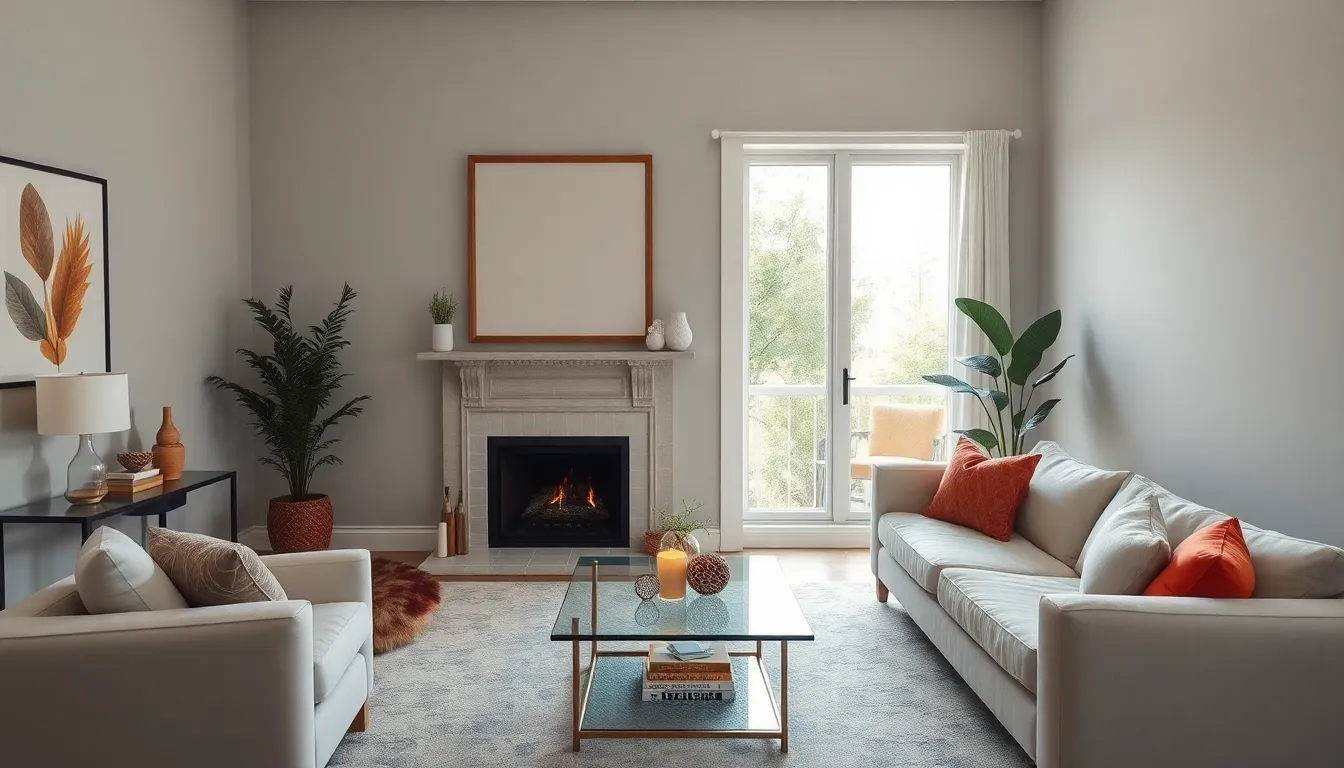
Light colors and reflective surfaces work together to create the illusion of expanded space in compact living rooms with fireplaces.
Paint Colors That Open Up the Space
Neutral color palettes transform small living rooms by creating an airy, spacious atmosphere that doesn’t compete with your fireplace’s natural focal point. We recommend whites, creams, and soft grays as your primary wall colors since these shades reflect light effectively and prevent visual clutter that can make rooms feel cramped.
Pale colors on furnishings extend this spacious feeling throughout the room by maintaining visual continuity from walls to furniture pieces. Choosing light-colored sofas, chairs, and accent pieces ensures colors don’t compete for attention while allowing your fireplace to remain the star of the space.
Bold accent colors on the fireplace itself can create stunning visual balance without overwhelming your compact room. We suggest applying vibrant hues to the fireplace surround or mantel area, which draws the eye naturally while keeping the rest of the space neutral and open.
Strategic Use of Mirrors and Glass
Mirror placement above the fireplace creates instant depth and reflects both natural and artificial light throughout your living space. We position large mirrors directly above the mantel to capture and bounce light around the room, which enhances the fireplace’s ambiance while making the entire area feel more expansive.
Strategic mirror positioning throughout the room reflects natural light sources and creates multiple illusions of space from different angles. Placing mirrors beside the fireplace creates a wraparound effect that’s particularly effective in corner fireplace setups, making your living area feel more integrated and spacious.
Glass accents and furniture continue the reflective theme while maintaining an open, unobstructed feel in your compact space. We incorporate glass-topped coffee tables, glass shelving units, and glass decorative accessories to enhance the sense of openness without adding visual weight to your small living room design.
Add Cozy Textures Without Overwhelming the Room

Textures create warmth and depth in small living rooms with fireplaces while maintaining that essential sense of spaciousness. We’ll show you how to layer elements strategically without making your room feel cramped or cluttered.
Layered Rugs and Throw Pillows
Layered rugs bring instant coziness to your fireplace area without overwhelming the limited floor space. Position a small area rug directly in front of your fireplace to create an inviting conversation zone that naturally draws people toward the warmth. Stack a smaller accent rug over a larger neutral base to add visual depth while keeping the overall footprint compact.
Strategic pillow placement enhances comfort without consuming precious seating real estate. Choose throw pillows in complementary colors that echo your fireplace’s finish or surrounding decor to create visual harmony throughout the space. Mix different textures like velvet, linen, and knit fabrics to add tactile interest while sticking to a cohesive color palette that won’t fragment your small room’s visual flow.
Scale considerations prevent your textile choices from dominating the space. Select medium sized pillows rather than oversized ones that can swallow smaller sofas or chairs. Limit yourself to three to four pillows per seating area to maintain that uncluttered aesthetic we’ve been building throughout your living room design.
Window Treatments That Maximize Natural Light
Sheer curtains allow maximum light penetration while providing necessary privacy around your fireplace seating area. These lightweight fabrics create a soft, airy feeling that complements the warm glow from your fireplace without blocking precious natural illumination that helps your small room feel more spacious.
Adjustable blinds offer flexibility to control light levels throughout the day while maintaining your room’s open atmosphere. Choose white or light colored blinds that reflect light back into the space rather than absorbing it. Mount them close to the ceiling to create the illusion of taller windows and more vertical space in your compact living area.
Layered window treatments combine functionality with style by pairing sheer panels with heavier drapes that can be pulled back during daylight hours. This approach gives you privacy options for evening fireplace gatherings while ensuring your small living room receives maximum natural light during the day to balance the cozy fireplace ambiance.
Utilize Corner Spaces Effectively
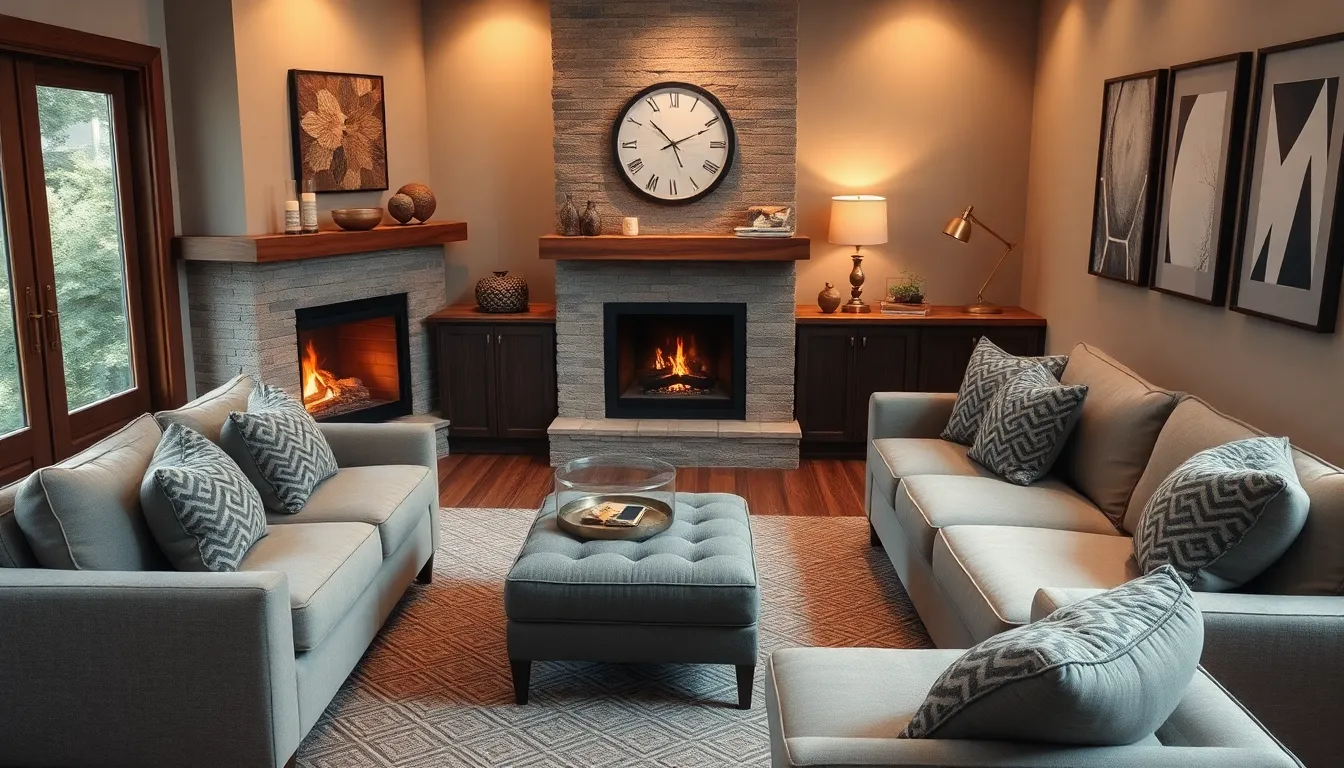
Corner spaces in small living rooms often go underutilized, yet they present some of our best opportunities for maximizing both function and style around a fireplace. Strategic corner placement can transform awkward angles into design assets that enhance the room’s flow.
Corner Seating Answers
Sectional sofas with corner pieces create the perfect intimate seating arrangement around your fireplace while maximizing every square foot. These L-shaped configurations naturally guide conversation toward the hearth and eliminate the need for additional chairs that might crowd the space.
Ottomans and poufs tucked into corners provide flexible seating options that double as storage answers. We can easily move these pieces when entertaining or tuck them away to create clear pathways through the room.
Built-in corner benches offer permanent seating that doesn’t intrude on walking areas. Adding cushions and throw pillows transforms these functional pieces into cozy reading nooks that complement your fireplace’s warmth.
Corner electric fireplaces themselves become space-saving focal points that fit into previously unused areas. This placement frees up valuable wall space for furniture arrangements while still providing the ambiance of a traditional hearth.
Diagonal Furniture Placement
Placing furniture at diagonal angles creates visual interest and improves traffic flow in compact living spaces. This arrangement technique makes rooms feel larger by drawing the eye along longer sight lines rather than straight across shorter walls.
Angling your sofa or chairs at 45-degree positions relative to the fireplace opens up natural walking paths. This diagonal approach prevents furniture from blocking movement while maintaining clear views of the fire from multiple seating positions.
Coffee tables positioned diagonally can serve multiple seating areas without creating barriers. This central placement encourages circulation around the furniture rather than forcing people to navigate tight spaces between pieces.
Strategic diagonal arrangements guide attention toward the fireplace as the room’s anchor point. By positioning key furniture pieces at angles that point toward the hearth, we create a natural focal hierarchy that makes the space feel both organized and spacious.
Create Visual Height With Lighting Design

Lighting design transforms small living rooms with fireplaces by drawing the eye upward and creating layers of illumination. We’ll explore strategic lighting placement that maximizes vertical space while improving the cozy ambiance around your fireplace.
Pendant Lights and Wall Sconces
Pendant lights create dramatic vertical lines that guide the eye toward the ceiling and expand perceived room height. We recommend installing pendant lights at varying heights to establish visual layers throughout your small living room. Positioning wall sconces flanking your fireplace adds symmetrical illumination while freeing up valuable floor and table space.
Wall sconces mounted at different elevations create a cascading light effect that makes ceilings appear taller. Installing sconces 6-8 feet above the floor provides optimal ambient lighting without overwhelming the room’s proportions. Multiple sconce pairs positioned at staggered heights throughout the space establish a cohesive lighting rhythm that complements your fireplace’s warm glow.
Pendant lights suspended over seating areas create intimate conversation zones while maintaining an open, airy feel. Choosing fixtures with upward-facing elements reflects light onto the ceiling and amplifies the room’s vertical dimensions. Glass or translucent pendant shades allow light to filter through multiple directions, improving the overall spaciousness of your compact living area.
Table Lamps at Varying Heights
Table lamps positioned at different elevations create depth and visual interest that prevents your small living room from feeling flat. We suggest placing taller lamps on lower surfaces like coffee tables and shorter lamps on elevated surfaces such as side tables or floating shelves. This strategic height variation draws attention upward while providing functional task lighting for reading or relaxing by the fireplace.
Varying lamp heights establishes a natural focal hierarchy that guides the eye through different zones of your living space. Positioning a tall floor lamp in one corner balances a shorter table lamp on the opposite side, creating visual equilibrium around your fireplace. Multiple lamp heights prevent the room from appearing monotonous while maintaining the cozy atmosphere that complements your fireplace’s warmth.
Layering different lamp heights provides flexibility for adjusting the room’s ambiance throughout the day. Taller lamps cast light over broader areas, while shorter lamps create intimate pools of illumination perfect for evening relaxation. This varied lighting approach allows you to customize the mood of your small living room based on activities and times of day.
Define Zones in Your Open Layout
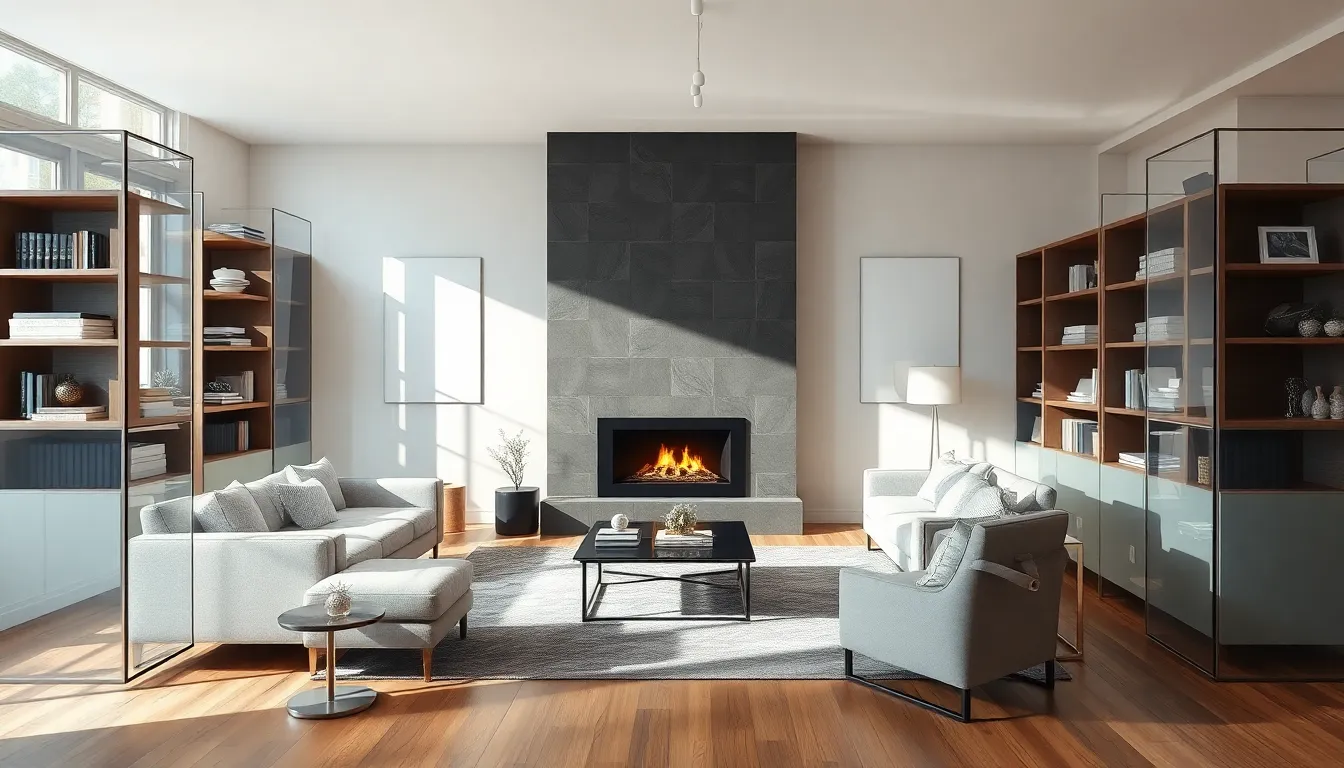
Creating distinct areas within your small living room helps maximize functionality while maintaining the fireplace as your central focal point. We’ll show you how strategic placement and visual separations can transform your compact space into multiple purposeful zones.
Room Dividers That Don’t Block Light
Transparent dividers offer the perfect solution for separating spaces without sacrificing your room’s open feel. Sheer curtains hung from ceiling tracks create soft boundaries between your seating area and other zones while allowing natural light to flow freely throughout the space. We recommend choosing lightweight fabrics in neutral tones that complement your fireplace surround.
Glass panels and acrylic dividers maintain visual connectivity while defining separate areas within your living room. These modern answers work particularly well when positioned perpendicular to your fireplace wall, creating an intimate conversation zone around the hearth. Clear materials ensure your room maintains its spacious appearance while providing functional separation.
Bookshelf room dividers with open backs serve double duty by providing storage and creating zones without blocking light transmission. Position these strategically to frame your fireplace seating area while maintaining sightlines across the entire room. We suggest keeping shelves partially filled to preserve the airy aesthetic while adding personality through carefully curated displays.
Area Rugs to Separate Spaces
Strategic rug placement creates instant visual boundaries that define your fireplace zone and other living areas. Place a medium sized area rug directly in front of your fireplace to anchor your seating arrangement and create a cozy conversation circle. We recommend choosing rugs that extend at least 12 inches beyond your furniture footprint to properly define each zone.
Contrasting rug colors and patterns help distinguish different areas within your open layout without physical barriers. Use a warm toned rug near your fireplace to enhance the cozy ambiance, then introduce a complementary but distinct pattern in your dining or work zone. This color coordination creates visual flow while maintaining clear area definitions.
Layered rugs add depth and texture while creating multiple zones within larger areas of your living room. Start with a larger neutral base rug, then layer smaller accent rugs to define exact seating arrangements around your fireplace. We find this technique particularly effective in studio apartments where the living room serves multiple functions throughout the day.
Conclusion
We’ve shown you that small living rooms with fireplaces don’t have to feel cramped or overwhelming. With the right approach to furniture selection vertical storage and strategic lighting you can create a space that’s both functional and inviting.
Remember that every square foot counts in compact spaces. By implementing multi-functional pieces maximizing corner areas and using light colors with reflective surfaces you’ll transform your room into a cozy sanctuary that feels much larger than its actual dimensions.
The key is balancing your fireplace’s natural focal power with smart design choices that enhance rather than compete with it. Start with one or two strategies that resonate most with your style and gradually build from there. Your small living room can become the warm welcoming heart of your home.
Frequently Asked Questions
How can I maximize storage in a small living room with a fireplace?
Utilize vertical space with floor-to-ceiling built-ins and custom shelving around the fireplace. Wall-mounted solutions like floating media consoles and modular systems free up floor space. Consider corner shelving and above-door storage to use every available inch while maintaining visual balance.
What furniture works best in small living rooms with fireplaces?
Choose multi-functional pieces like ottoman storage benches, nesting tables, and expandable dining tables. Sofa beds and convertible seating like daybeds provide dual purposes. These versatile options maximize functionality without requiring permanent floor space, perfectly complementing your fireplace setup.
How should I arrange furniture around a fireplace in a small room?
Position seating at 45-degree angles to create intimate conversation areas while improving traffic flow. Float furniture away from walls to enhance circulation and create breathing room. Place coffee tables or ottomans centrally to encourage movement and provide additional storage opportunities.
What colors make small living rooms with fireplaces look bigger?
Use neutral palettes like whites, creams, and soft grays for walls to maintain an airy atmosphere. Light-colored furnishings extend the spacious feeling, while bold accent colors on the fireplace create visual balance. This approach complements the fireplace while maximizing perceived space.
How can mirrors help expand a small living room with a fireplace?
Place a large mirror above the mantel to reflect light and create space illusion. Position mirrors to capture natural light sources for additional brightness. Mirrors beside the fireplace create a wraparound effect, particularly effective in corner setups, making the area feel more integrated and spacious.
What lighting works best in small living rooms with fireplaces?
Create layers of illumination using pendant lights and wall sconces for vertical lines and symmetrical lighting. Place table lamps at varying heights to add depth and visual interest. This approach draws the eye upward, makes ceilings appear taller, and complements the fireplace’s warmth.
How do I style a fireplace mantel in a small living room?
Keep decorating minimalist with a few statement pieces to avoid clutter and maintain visual balance. Rotate seasonal items to refresh the appearance while adhering to a clean aesthetic. This approach prevents overwhelming the space while highlighting the fireplace as a focal point.
Can corner spaces be useful in small living rooms with fireplaces?
Absolutely! Use corner seating solutions like sectional sofas and built-in benches to create intimate arrangements. Add ottomans and poufs for flexible seating and storage. Corner electric fireplaces can serve as space-saving focal points while maximizing every inch of available space.
How do I add coziness without overwhelming a small space?
Layer rugs to create warmth and depth, positioning a small area rug in front of the fireplace for conversation zones. Use strategic pillow placement with medium-sized options in complementary colors. Choose window treatments like sheer curtains that maximize natural light while maintaining privacy.
What are the best ways to define zones in an open small living room?
Use transparent dividers like sheer curtains and glass panels to create soft boundaries without blocking light. Bookshelf room dividers provide dual storage and space-defining functions. Strategic rug placement with contrasting colors helps distinguish different areas while maintaining spaciousness around the fireplace.

